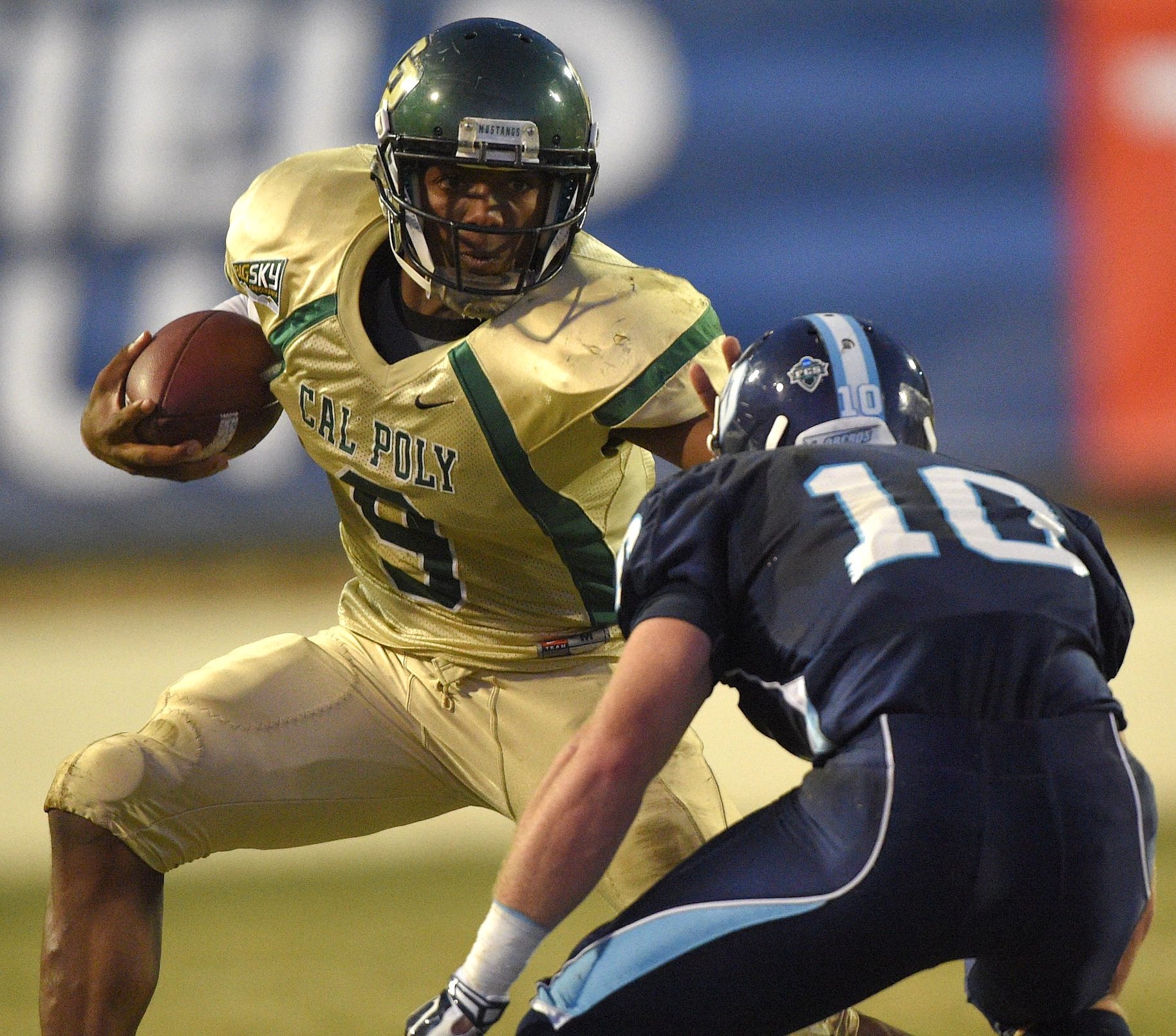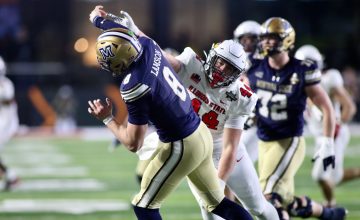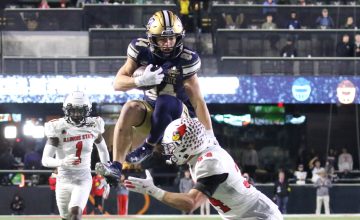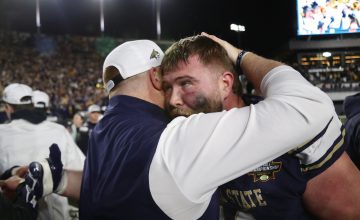Editors note: This story originally ran on August 21, 2015 on Skyline Sports. Throughout the year we will re-post stories relevant to weekly match-ups.
Chris Brown is a rare breed, an option quarterback in the most prolific offensive league in the country. Brown, a Cal Poly senior, has always been a little different. At a young age, he realized his wizardry in the option game could be his ticket to a better life.
Brown grew up in Compton, California. While at Dominguez High, the storied school that has produced a slew of athletes like NBA Hall of Famer Dennis Johnson and Seattle Seahawks All-Pro cornerback Richard Sherman, Brown learned the nuances of the Wing-T offense. When he wasn’t carrying the ball, he was blocking defensive ends for the ball carrier.
He sometimes dreamed of the glitz and glamour that comes with being a gun slinging quarterback. But he also realized that the toughness and unique skills he honed in an archaic offense could be his way out of one of America’s roughest areas.
“I realized early that sports could get me somewhere and out of the position I was in,” Brown said in July at the Big Sky Kickoff media conference in Park City, Utah. “My parents (Terrance Sr. and Christina Brown) were huge on education too. My brother (Terrance Jr.) went to Stanford and I went to Cal Poly. We are blessed to be in the position we are in. Education is something that our parents harped on and that’s been our avenue out more than anything.”
Growing up in Compton meant experiencing loss as an adolescent. The city is notorious for its crime. The FBI has consistently ranked the Los Angeles suburb as one of America’s most dangerous cities for much of the last 25 years. There were 42 homicides in the suburb of 96,500 in 2010 alone.
“Nothing came easy,” Brown said. “Born and raised in Compton made me the man I am today. The experience I’ve experienced, the people I lost has shaped me into the person I am. I wouldn’t change anything about it. I love the place I came from. I believe there are times this year where I was able to think about past events I’ve been through and I have been able to use that as motivation to play to my best abilities. I am playing for the people that weren’t able to make it out, the people I lost along the way.”
After back-to-back standout seasons at Dominguez, Brown chose Cal Poly — considered one of the premier public institutions in the West — over Hawai’i, Fresno State and Nevada because of his academic pursuits.
“The foundation he came from at home is a great foundation,” Cal Poly head coach Tim Walsh said in July. “You look at his brother, Terrance, and you look at mom and dad, the thing they have is they helped their young men make decisions on where they are going to college. Terrence choosing Stanford and Chris choosing Cal Poly shows me they get the whole picture. They understand the value of the degrees you can earn from those places.”
As much as the communication major shines off the field — he’s the head of a non-profit that benefits athletes with disabilities — he might be the Big Sky’s most important offensive player on it as well.
“He definitely is one of the most important players in the league,” Montana State head coach Rob Ash said. “To be honest with you, I’m as concerned with him as any single player in the conference. That’s a strong statement but I really am. The thing that is so scary with those guys is with him running that triple option, you can go a whole quarter and not see the ball. They almost did it to us last year. At the end of the game, that’s how they beat us. Plus, he can rip off a big chunk and make a big scoring play too. He’s really, really talented and tough. I’m very, very impressed with that young man.”
Last fall, Brown proved he’s as tough as they come. As the triggerman for the Mustangs’ triple option offense, Brown ran the ball an eye-popping 249 times for a Big Sky Conference quarterback record 1,265 yards. He scored 17 touchdowns on the ground and caught a touchdown pass for good measure. He also completed 60 percent of his passes for 1,465 yards and 12 touchdowns compared to just three interceptions.
“The way that they highlight their quarterback, they are going to go as that kid goes and when Chris Brown is hot, I’m not sure there’s anybody better than him,” Northern Arizona head coach Jerome Souers said. “He’s a phenomenal athlete. They talk about option quarterbacks don’t throw as well. Well, he hit about three 15-yard comebacks against us that drop-back quarterbacks don’t throw as well. He put them right on the money. I have a lot of respect for that kid.”
Last season, Cal Poly averaged 34 points per game with an offense that possessed the football for almost 32 minutes per game. CP piled up a Big Sky record 4,221 yards, good for an FCS-leading 352 yards per game. The Mustangs scored 44 touchdowns on the ground. It seems the choice to go with Brown midway through the 2013 season over prep All-America Dano Graves is paying off.
“Chris Brown’s development has given us the confidence that we can score points on anyone in the country,” Walsh said. “I really do think he is one of the most exciting players in the country. He’s not going to throw it 30 or 35 times a game but he’s going to run it 20 times a game and when he has the ball in his hands, you better defend him because he’s extremely exciting.”
The problem for Cal Poly again this season will be keeping Brown fresh. Last fall, Brown led the Mustangs to back-to-back wins over Montana (41-21) and Montana State (35-27) to earn a spot in the Big Sky title race. The following week against Idaho State, Brown carried the ball 39 times for 195 yards and three touchdowns but the ‘Stangs fell, 30-28.
“He single-handedly put them on his back and said, ‘Let’s go for the conference title,’” ISU head coach Mike Kramer said. “The final score, 30-28 and we held him on fourth down. He’s dynamic. That’s why they are my favorite to win the league. They are tough, they are resilient, they are out of the groove, they are dynamic, they are mindful of what their opportunity is and they have good tradition. Pound for pound, man for man, they are the toughest team in the league and that’s because they have the toughest player in the league.”
The following week, a banged up Brown could only muster 24 yards on 15 carries as CP fell victim to an upset against rival UC Davis. The 48-35 loss to the Aggies kept Cal Poly out of the playoffs.
“That’s the ongoing discussion we have almost every day in our office is how do we make sure Chris in Game 12 is as healthy as he was in Game 1?” Walsh said. “The reality of the situation is if we don’t use Chris Brown’s athletic ability to the utmost, then we are probably not giving our team the opportunity to win every game we play. So he’s going to have to be the playmaker for us. Can we monitor him? Yes. But really, the people who are really going to make the decision for us are in this room (Big Sky coaches). If they decide to take him away, then we are going to have to have other guys step up to the plate and be explosive.”
Brown has proven he can dominate a game. He has proven he can go toe to toe with some of the best teams in the Big Sky. But he hasn’t proven he can get Cal Poly into the postseason. The Mustangs shared the league title their first year in the Big Sky in 2012 with Andre Broadus operating the triple option. In 2013, an overtime loss to Montana, a 17-13 misstep against NAU and a Nov. 16 35-22 loss to Eastern Washington kept Cal Poly home. And last season, an upset late in November thwarted the playoff pursuit.
This fall, Brown hopes to rewrite the narrative.
“We haven’t finished well,” Brown said. “The year we got this ring (BSC championship ring on his hand), we finished each game. Not to say we weren’t working hard but it’s just that those games we came up short, we could’ve finished our drive a little stronger. We are planning to have a better year this year and finishing. If we can do that, expect big things.”
Action photos courtesy Cal Poly Athletics. Head shot by Brooks Nuanez. All Rights Reserved.
















